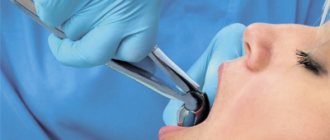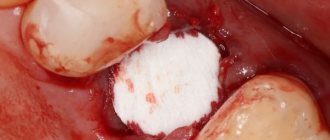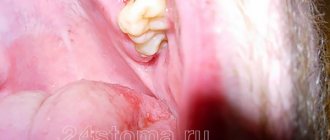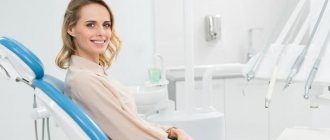Before surgery, it is necessary to carry out professional oral hygiene.
If the operation is performed with an anesthesiologist, you must come with an accompanying person, or the operation will be cancelled.
Recommendations for surgical treatment
After surgery, you may experience pain, which will go away as the tissue heals. Postoperative swelling or hematoma can also occur in areas adjacent to the surgical site, which is a natural consequence of surgery. There may be a slight increase in body temperature.
Please follow our recommendations!
Operation stages
The surgical algorithm for removing the third molar is as follows:
- consultation with a surgeon with visual, radiographic diagnostics and examination on a computed tomograph. The obtained research results give the dentist a clear picture of the problem of a particular patient;
- If there are indications for surgery, the doctor will find out if the patient is allergic to medications. Next, an anesthetic is injected into the gum;
- After the anesthesia takes effect, the doctor begins surgical procedures. The course of the operation corresponds to the protocol of simple or complex removal, depending on the current situation;
- At the end of the operating stage, the surgeon gives the patient the necessary recommendations.
Before surgery
- Prepare an ice pack at home.
- On the day of surgery, eat a light meal 2-3 hours before your scheduled time.
- The day before surgery, the consumption of alcoholic beverages is strictly prohibited.
- Be sure to inform your dentist about all the individual characteristics of your body and any allergic reactions, in order to accurately select an anesthetic that is safe for you.
- Visit the toilet before surgery.
- It is better to come to the operation in loose clothes without a collar.
After operation
— To avoid severe swelling and bleeding during the first 24 hours after surgery, it is necessary to apply an ice pack to the cheek on the side of the operation for 15-20 minutes with breaks of 30-40 minutes.
- Rinsing your mouth when bleeding is unacceptable!
— After sinus lift surgery, you should not drink through a straw, blow your nose vigorously, or puff out your cheeks.
- To reduce the likelihood of nosebleeds (after upper jaw surgery) and reduce post-operative swelling, you should sleep with your head elevated (add an extra pillow) for several days after surgery.
— It is not recommended to use tobacco products 1 week before and 2 weeks after surgery.
— It is prohibited to drive a car on the day of surgery with premedication.
- It is not recommended to eat until the anesthetic wears off. In the first days after surgery, it is recommended to eat soft, non-hot foods.
— It is not recommended to drink alcohol, coffee, or strong tea to avoid the negative effects of these drinks on blood circulation and wound healing.
Chapter 8. TOOTH EXTRACTION OPERATION
Tooth extraction
(extractio dentis)
is one of the most common operations in outpatient dental practice.
Tooth extraction is a forced rupture of the tissues connecting the root of the tooth with the walls of the socket and gum, and its removal from the alveoli.
The tooth extraction operation has a number of features. It can be either incredibly simple and easy, or complex, sometimes lasting for hours, requiring a complex set of instruments, general anesthesia and hospital conditions. When a tooth is removed, a fracture occurs in the socket, the walls of which inevitably move apart with open access to the spongy substance and bone marrow. In some cases, complications may arise, both local (inflammatory phenomena) and general - disruption of the cardiovascular, digestive and other systems.
INDICATIONS AND CONTRAINDICATIONS FOR TOOTH EXTRACTION OPERATION
There are indications and contraindications for tooth extraction surgery (Diagram 8.1, Tables 8.1, 8.2).
Scheme 8.1.
Indications and contraindications for tooth extraction surgery
Table 8.1.
Indications for tooth extraction surgery
| Indications | Reasons for deletion | Justifications |
| Urgent | Acute periapical inflammatory processes in the periodontium, causing osteomyelitis, abscess, phlegmon, sinusitis, lymphadenitis | Delay leads to progression of the inflammatory process, aggravating the general condition of the patient up to sepsis |
| Longitudinal fracture of a tooth exposing the pulp | The integrity of the tooth cannot be restored using therapeutic and orthopedic methods. | |
| Tooth in jaw fracture line | Prevents the reposition of jaw fragments. Promotes inflammatory-traumatic osteomyelitis | |
| Planned | Failure of endodontic treatment for chronic forms of periodontitis | Leads to immunodeficiency and chronic sepsis |
| Significant or complete destruction of the tooth crown, degree III mobility | Impossibility of therapeutic and orthopedic treatment | |
| Teeth that did not erupt on time or partially erupted (impacted and semi-impacted, dystopic in the presence of clinical manifestations) | Cause odontalgia, inflammatory processes in the mucous membrane of the oral cavity, tongue, chronic injury of the oral mucosa | |
| Incorrectly positioned teeth, protruded as a result of the loss of an antagonist (Popov-Godon phenomenon), converging, diverging, supernumerary teeth located outside the dental arch | Inability to correct the occlusal surface, difficulty chewing |
Table 8.2.
Contraindications to tooth extraction surgery
| Contraindications | Justifications | |
| Are common | Cardiovascular (pre-infarction conditions and within 3-6 months after myocardial infarction, hypertension during a crisis, coronary heart disease with frequent attacks of angina pectoris, etc., taking anticoagulants) | Requires special training in an anesthesia room or hospital setting |
| Blood disease - hemophilia, hemorrhagic diathesis, anemia, leukemia | Requires special training in an anesthesia room or hospital setting | |
| Infectious diseases (influenza, acute respiratory disease, erysipelas), pneumonia | Decreased body resistance. The operation is carried out after treatment by specialists | |
| Traumatic brain injury (bruise, concussion) | Additional trauma is associated with cerebral edema. The operation is performed in a neurosurgical department | |
| Acute diseases of the gastrointestinal tract, liver, kidneys, diabetes mellitus, etc. | The operation is carried out only after treatment by specialists and consultation with an anesthesiologist. | |
| The period before and during menstruation | Disturbance of the blood coagulation system - possible bleeding | |
| Pregnancy | Optimal timing for surgical debridement is from the 3rd to the 7th month of pregnancy | |
End of table. 8.2
| Contraindications | Justifications | |
| Local | A tooth located in the area of a malignant or benign tumor of the alveolar process | Possibility of malignancy or spread of metastases |
| Conducting radiation therapy for malignant tumors in the oral cavity | Possibility of radiation necrosis | |
| Ulcerative-necrotic processes in the oral cavity | Spread of necrosis | |
MEASURES TAKEN BEFORE TOOTH EXTRACTION OPERATION
Examination.
Before proceeding with tooth extraction, it is necessary to examine the patient: find out complaints, the presence of previous and concomitant diseases, collect an anamnesis of the disease, and allergological status. Data from the survey and examination of the external and oral cavity allow us to identify the presence of indications for surgery (Table 8.3).
Table 8.3.
Activities taken before tooth extraction surgery
| Sequence of stages | Execution method | Rationale |
| Conversation with the patient. Examination of the tooth to be removed | Establishing psychological contact with the patient. When examining a tooth, determine the degree of destruction of the crown and its mobility, and determine the presence of inflammation. Carefully examine the X-ray data | Reducing psycho-emotional stress to prevent fainting, collapse, shock. The examination allows you to identify indications for tooth extraction, outline a plan for surgical intervention, choose a method of pain relief, determine the surgical technique and the necessary instruments. An x-ray allows you to determine the condition of the bone tissue in the root area, the size of resorption, the relationship of the roots with the bottom of the nasal cavity, sinuses, and mandibular canal |
| Preparing the mouth before removal | Removal of dental plaque from the causative and adjacent teeth. Antiseptic mouth rinse | Prevention of possible inflammatory complications |
| Preparing the patient in the chair | When removing teeth in the upper jaw, the surgical field is at the level of the surgeon’s shoulder joint (Fig. 8.1). The patient's head is thrown back and turned in the opposite direction. When removing teeth in the lower jaw, the surgical field is located at the level of the elbow joint of the surgeon’s hand (Fig. 8.2, 8.3). The patient's position is semi-recumbent, the headrest is vertical | The correct position of the patient in the chair ensures optimal visibility of the surgical field and the tooth extraction operation. |
End of table. 8.3
| Sequence of stages | Execution method | Rationale |
| Lighting | Directing the beam of light from a dental lamp into the surgical field | The operation requires good natural and artificial lighting. |
| Preparing the surgeon's hands in compliance with the rules of asepsis | Before the operation, you must wash your hands with soap and a brush in running water, dry with a towel, and wear sterile disposable gloves. | To avoid contamination of microorganisms in the surgical field, the doctor performs all manipulations wearing a mask, safety glasses, and sterile disposable gloves. |
| Preparing instruments for inspection | The sterile tray contains tweezers, a spatula and sterile gauze swabs. A nurse gives a tray with sterile instruments | |
| Anesthesia | Carrying out adequate anesthesia according to indications | Prevention of painful shock |
| Tools and materials for tooth extraction surgery | The sterile tray contains tweezers, a spatula, sterile gauze swabs, a carpule syringe, injection needles, carpules with anesthetic, a sickle-shaped smoother, forceps and elevators according to the tooth or root being removed, and a curettage spoon. A nurse gives a tray with sterile instruments | |
| Instruments and materials required in case of complex removal and local complications of the operation | Additional tools and materials: hemostatic sponge, iodoform turunda, suture material, needle holder, scissors, scalpel, burs, straight tip and Farabeuf hook. A nurse gives instruments urgently during a complicated operation. |
The doctor must carefully examine the tooth to be removed. When examining the crown, you need to establish the degree of its destruction, the anomaly of the tooth and, depending on this, select the appropriate forceps or elevators, determine the presence of inflammation, and the degree of pathological mobility of the tooth. Using an x-ray, it is necessary to establish the condition of the bone tissue in the root area, the nature and size of bone resorption or the type and size of hypercementosis, the number, shape, size and degree of divergence or fusion of the roots of the tooth, as well as their relationship with the bottom of the nasal cavity, the maxillary sinus, the mandibular canal . It is important to find out whether the roots of the tooth are connected by a septum, whether it is strong, and whether it is advisable to pre-sever the roots.
Additional Tips
Avoid lifting heavy objects, bending over, playing sports, or taking hot baths for 5 to 7 days after surgery.
Within a few days, performance and the ability to drive may be reduced.
Remember to take medications prescribed by your dental surgeon after surgery.
We kindly ask you!
Appear for examination and removal of stitches 5-7 days after surgery, in agreement with your surgeon. You must immediately notify your surgeon or clinic administrator of any changes in your health.
Recommendations for caring for dental implants
The service life of the implant depends on:
- The correctness of the surgical and prosthetic stages carried out in the dental clinic.
- The patient's compliance with the recommendations given by the dentist immediately in the postoperative period and the period after implant prosthetics.
- Careful hygienic care of the “implant-crown” structure.
- Blood supply to bone tissue and gums in the area of implantation. (Smoking cigars and cigarettes has a very, very negative effect on peripheral blood circulation, which can even interfere with implant implantation.!!!)
In what cases should a wisdom tooth be removed?
Modern dentistry is focused on preserving the patient’s natural teeth. But under certain circumstances, extraction of third molars is necessary. Let us dwell in detail on each of the indications for removal.
Dystopia
– incorrect position in the dentition. Symptoms: gum inflammation, pain. Causes:
- genetic predisposition;
- formation defects during intrauterine development of the fetus;
- malocclusion (including after injury);
- small jaw size;
- early loss of baby teeth.
Dystopia comes in different types. The tooth can protrude relative to the jaw forward, backward, or be rotated around its axis, growing towards the cheek, tongue, or throat. If the element has not erupted (impacted), then it can grow horizontally inside the gum and abut the adjacent molar.
Retention
– the tooth is covered by gum tissue or bone, i.e. it cannot erupt, although it is fully formed. An impacted third molar is a source of inflammation, and cyst formation is possible.
Retention classification:
- according to the degree of immersion in the gingival tissue - completely impacted (not visible from under the gum) and partially impacted (slightly visible on the surface);
- according to the position of the crown part relative to other teeth: vertical retention (normal vertical growth vector), horizontal (grows in the gum perpendicular to adjacent teeth), angular (is inclined);
- by depth of immersion in tissue: located in soft tissue or in the jaw bone. The first option is considered standard and does not cause any particular difficulties during removal.
Reasons for retention:
- hereditary factor;
- lack of microelements during pregnancy;
- poor nutrition – a decrease in solid food in the diet, which caused a decrease in chewing load;
- untimely loss of baby teeth (too early or too late);
- pathology of jaw development;
- close arrangement of dental elements;
- excessively dense structure of gum tissue.
Extensive caries damage, pulpitis, presence of a cyst on the root. Access for treatment of “eights” is difficult, as is hygienic care for them. Therefore, dentists find treatment of such teeth inappropriate and recommend removal.
It often happens that the third molar has all the problems listed above, so extraction of such a specimen presents certain difficulties. This situation is a reason for an immediate visit to the dental clinic. Otherwise, the patient is not protected from abscess, phlegmon and osteomyelitis.
This is interesting: dentists in some countries insist on preventative measures for wisdom teeth. They remove “eights” without indications (i.e., healthy units that have erupted normally). In this way, they eliminate problems before they arise. Such measures are not popular in Russia.
Oral hygiene
Regardless of the size or number of implants, they must be cared for as if they were regular teeth. Brush and floss your dental implants twice a day. Use special fluffy dental floss (for example, Oral-B superfloss or ultrafloss).
When brushing your teeth, pay special attention to the back teeth and between teeth. Use a soft or medium-hard brush. In addition, use an irrigator for additional deep cleaning of the interdental spaces with water irrigation.
There are special brushes that can be used to clean interdental spaces - dental brushes. Ask your dentist about them - in some cases they are not recommended.
Visit your dental hygienist twice a year; they are the only ones who can clean your implants as thoroughly as necessary. Regular visits to the dentist are very important. Your dentist will check the condition of your gums, jaws and implants.
Smoking is bad for your health and for dental implants, too. To have a good prognosis for the lifespan of your implants, it would be a good idea if you stopped smoking.
Two surgical options
The surgical procedure is planned by the surgeon depending on the severity of the clinical case. Dentists differentiate extraction into standard (simple) and complex. Differences between complex wisdom tooth removal and simple:
- the need to cut the gums and subsequent suturing;
- the use of special surgical instruments, in addition to forceps and an elevator (scalpel, drill, chisel, chisel).
A simple extraction is performed quickly, in 3 to 10 minutes (excluding pain relief time). The technology is as follows: forceps are applied to the tooth, rocked a little, slightly rotated around its axis, and then pulled out of the socket.
Complex removal involves plastic surgery of soft and sometimes hard tissues. Such manipulations significantly lengthen the operation time (up to 1.5 hours) and the duration of the rehabilitation period (up to 14 days). The type of surgical intervention is determined by the surgeon after detailed (including hardware) diagnostics. As a rule, complex extraction is performed when there is severe dystopia and/or retention, when there is severe destruction of a tooth or its roots, or when extracting a molar in the lower jaw. The bone structure of the lower jaw is much denser than that of the upper jaw, so a more serious approach is required.
Important: removing wisdom teeth on your own is unacceptable. Unqualified actions can lead to all sorts of complications. For example, a molar breaks into fragments, infection enters the wound.
Eating
Avoid chewing hard candy, ice, or other hard foods (such as hard chocolate or dry fish) as they may loosen or break the abutment screw.
Avoid foods such as caramel or toffee, as they may stick to the crown and cause the abutment screw to loosen.
Do not open bottles or crack nuts with your teeth for the same reasons.
Wear protective sports mouth guards when participating in sports and avoid direct blows to the face.
Refrain from grinding your teeth. If creaking occurs unintentionally or during sleep (bruxism), notify your dentist and he will make you a thin night guard.
The length of their service depends on the quality and regularity of care for implants.
Before and after implantation
Before surgery:
Prepare several days off after the date of the planned operation.
Do not smoke or reduce the number of cigarettes you smoke.
If you are sick on the eve of the operation, please notify the implantologist.
Ask your implantologist about the medications you will need immediately after surgery.
Patients suffering from compensated diabetes mellitus must follow a strict diet 2 weeks before surgery and 2 weeks after it.
Get a good night's sleep the night before surgery.
Make sure you are accompanied if you plan to undergo anesthesia, sedation or a complex operation, do not plan to be behind the wheel.
If you have herpetic rashes on the mucous membrane, the operation should be rescheduled.
After operation:
If you have had dental implants, you may experience some of the typical discomforts associated with any type of dental surgery. These may include:
- Swelling of the gums and face.
- Gum injury.
- Mobility of adjacent teeth.
- Pain at the implantation site.
- Minor bleeding.
- Bruises and bruises.
You may need painkillers and antibiotics. Follow the recommendations of the implantologist.
What must be observed after implantation:
- Brush your teeth with a soft brush before removing sutures
- Eat soft foods for 5-7 days. Do not eat hot, spicy or salty foods.
- Starting from the third day after surgery until the sutures are removed, you should rinse your mouth with a chlorhexidine solution twice a day (after brushing your teeth).
- Do not overheat in the sun or in a sauna.
- Do not engage in active sports.
- Do not smoke or reduce the number of cigarettes you smoke.
- Do not fly on an airplane, do not swim, do not dive for 2 weeks (especially important after sinus lift surgery).
- Do not blow your nose or sneeze with your mouth open (especially important after sinus lift surgery).
- If swelling, discomfort or other symptoms increase within a few days after surgery, or the temperature rises, contact your implant surgeon.
- After tooth extraction
- If you have had a tooth removed, you must take care of your oral cavity. By following certain recommendations, you will feel better and healing time will speed up.
Contraindications
There are contraindications to removal, these include:
- aggravated form of cardiovascular diseases;
- any infectious exacerbation;
- pathologies and poor blood clotting;
- strokes;
- mental illness;
- heat;
- stomatitis.
The doctor is also obliged to examine the patient and rule out a negative reaction to painkillers. After this operation, it is necessary to monitor the patient’s condition and exclude bleeding, severe pain and inflammation. Tooth extraction with a professional approach does not pose a threat to health or life and is part of the normal practice of a dentist.
The New Technologies Clinic provides modern technologies. Call us now!
Stopping bleeding:
To control bleeding, it is necessary to bite down on a gauze pad placed by the dentist in the oral cavity. The pressure promotes the formation of a blood clot in the socket. If you have heavy bleeding that has not stopped within an hour of tooth extraction, you should bite into a regular tea bag. Tannin in tea helps in the formation of blood clots. Hold the tampon or tea bag until the bleeding stops.
Additionally, cool the extraction area, apply a cold compress to the face in the area of tooth extraction for 10-15 minutes. at one o'clock. A slight bleeding on the first day after removal is normal.










